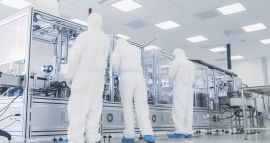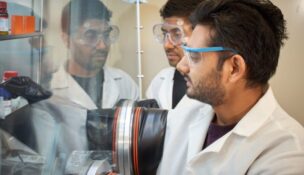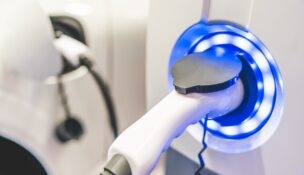

S.C. auto industry braces for continued shortage
Molly Hulsey //April 7, 2022//
![]() This story first appeared in the April 4 print edition of GSA Business Report.
This story first appeared in the April 4 print edition of GSA Business Report.
When Ukraine’s largest neon suppliers halted production in early March, it was a distress flare to an already beleaguered semiconductor industry.
The Eastern European nation supplies the 70% of the world’s neon and 90% of the purified neon used to etch circuits into a chip’s silicon surface in the United States, according to Gabrielle Athanasia, program coordinator for the Center for Strategic and International Studies. About 40% of the world’s krypton, another ingredient in the recipe of gases for lasers used in chip production, is also sourced from Ukraine.
So when larger chip manufacturers got a whiff of a potential Ukraine invasion, they rushed the market. Neon prices quadrupled in China between October 2021 and February 2022, Athanasia says in her report. The global price of krypton did the same within the month of January.
The long-term consequences have yet to be seen but for now, South Carolina OEMs and suppliers see the element bottleneck as yet another wave in the storm that pummeled the chip market even before 2020.
“I think the chip shortage certainly came to the general public’s attention, obviously in the beginning of the pandemic,” said Amy Tinsley, executive director of the S.C. Automotive Council. “And even though it may have ebbed and flowed, it has never gone away since that time. So I think the important thing to recognize is that demand for semiconductors has continued to increase over the past several years as products, not just in the automotive sector, but many sectors — consumer electronics, things like that — as the demand for those products have grown.”
With the migration to the home office in 2020, the need for personal electronics spiked. Car sales may have slumped early on in the pandemic, but consumer demand for vehicles with ever more sophisticated technology hasn’t gone anywhere.
And according Tinsely, neither will the bottleneck. Some industry experts expect the crunch to dissipate by 2023 at the earliest.
“The good news is that in the past year and a half, two years, many companies both in the U.S. and abroad have announced significant investment in either new production facilities or the expansion of existing facilities,” she said. “So that is really promising. But those facilities are extremely expensive to build, and they also require a pretty good amount to come into production before that extra capacity will be online.”
No factory can be built in a day, and semiconductor plants takes longer than many.
The OEMs that Tinsely works with have taken advantage of diverse products, suppliers and locations to “manage the best they can” during the shortage. But to some extent, suppliers may take more of a blow for a less diverse portfolio, she said.
“It can be really complicated, because you may have a supplier that does just one thing for just one OEM, so that’s more impactful to their business,” she said. “Or you might have someone that does the same product, maybe with some modifications, and supplies seven OEMs. So maybe they’re a little bit better off because five of their OEMs are running and two might have a pause.”
One Gray Court-based supplier, ZF, has been working overtime across its various locations to adjust to the chip shortage, according to spokesman Tony Sapienza.
“There is an impact to the industry,” he said when asked about the continued bottleneck. “But speaking of ZF, we have not seen an imapct because of Ukraine quite yet.”
On March 28, the U.S. Senate approved a bill to provide $52 billion in subsidies for U.S. chip manufacturers, following years of debate on the topic.
“Clearly, there is a need for more capacity and we would support that,” Sapienza told SC Biz News.
The chassis technology industry supplies BMW Plant Spartanburg, where the bottleneck had not slowed production, CEO Robert Engelhorn told SC Biz News at the S.C. Automotive Summit on March 2.
“We can say at least for last year, we did not lose one single car,” Plant Spartanburg’s top executive said.
Instead, the company adjusted to keep the production line moving. In November, BMW eliminated touch screens from at least four Spartanburg-made models until the chip market opens up again, according to a previous report.
“For sure, we will see further shortages throughout this year, and for sure, be affected by the worldwide crisis situation,” Engelhorn said. “We have to work closely with our suppliers to resolve these topics and see how we can improve the overall situation in the next months and in the years to come.”
Volvo Cars in Ridgeville could not comment on the overall shortage, but noted that the crisis in Ukraine itself had not yet created a dent in the facility’s production of the S60 model. Despite uncertainty of when the bottleneck will clear, production at Charleston’s Mercedes-Benz Vans continues to roll forward at a regular clip, according to spokesperson Jamila Anderson.
“The situation is still volatile, and we are constantly reevaluating what this means for Mercedes-Benz Vans production,” she said in a statement to SC Biz News, adding that the plant remains poised for adjustments to production. “We are in close contact with our direct suppliers as well as with our semiconductor suppliers to continuously navigate the situation.”
F















